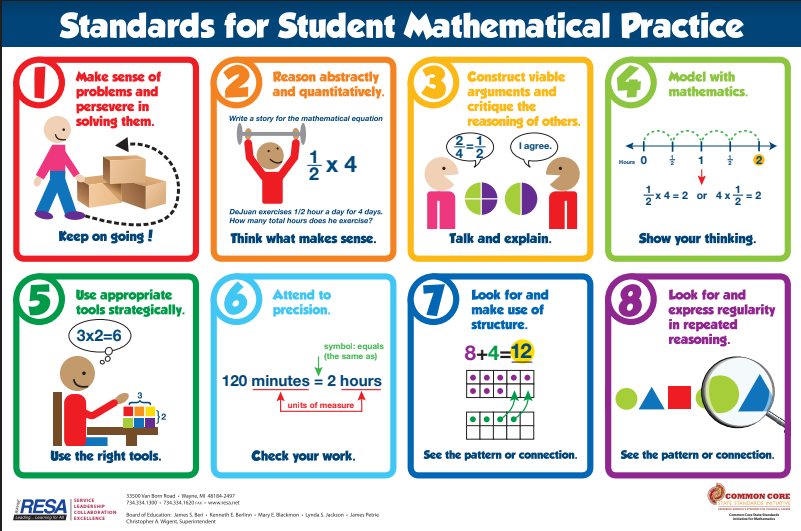Have a Question? Contact me: hforsyth@scholarcharter.org
Standards for Mathematical Practice
We will be using the eight mathematical practices all year long as we learn and grow in math. Each unit will provide multiple hands on learning activities to help students dive deeper into why math works the way that it does, instead of just learning the hows of doing problems. This helps to create an increased understanding and love of math. Below you will find the 8 Standards for Mathematical Practice:

Messages
Special Note About Homework:
Because homework is meant to be for practice, not for learning a new concept, it will not necessarily be given every night. The concepts that are being taught in 4th grade Math often require a few days to master. So, that means that we take more time in class for discussions, hands-on activities, and problem solving. When I feel that the students are confident with the concepts they have been taught, then I may send home the homework for that lesson. Thank you for your understanding.
Current Curriculum
In this unit we will be learning multiplication and division of multi-digit numbers. We will learn different methods and strategies for solving multiplication and division problems.
Math Vocabulary
Unit 1: Factors and Multiples
Composite Number: A whole number with more than one factor pair.
Factor: A number or quantity that when multiplied by another number produces a given number or expression.
Factor Pair: A pair of whole numbers that when multiplied together result in a specific number.
Multiple: The result of multiplying a number by another number.
Prime Number: A whole number greater than 1 that has only one factor pair (only 2 factors, 1 and the number itself).
Unit 2: Fraction Equivalence and Comparison
Common Denominator: The same denominator in two or more fractions.
Denominator: The bottom number in a fraction that tells how many equal parts the whole is divided (partitioned) into.
Equivalent Fractions: Two or more fractions that have the same value and represent the same point on a number line.
Number Line: A line on which numbers are marked at intervals, used to illustrate simple numerical operations.
Numerator: The top number in a fraction that tells how many of the equal parts are being described.
Unit 3: Extending Operations to Fractions
Mixed Number: A number that represents a whole number and a fraction less than 1.
Multiplication and Division
Associative Property of Multiplication: The property that states that the grouping of the factors does not change the product.
Commutative Property of Multiplication: The property that states that the order in which two numbers are multiplied does not change the product.
decompose: A way to break down a number into its factors.
dividend: A number that is being divided.
divisor: The number by which the dividend is being divided.
fact family: A group of related facts using the same numbers.
factor: A number that is multiplied by another number.
Identity Property of Multiplication: The property that states when any number is multiplied by 1, the product is that number (the identity doesn't change).
multiple: The product of a given number and any whole number.
product: The answer of a multiplication problem.
quotient: The answer of a division problem.
repeated subtraction: A strategy that can be used to divide.
Zero property of Multiplication: The property that states that any number multiplied by zero is zero.
Unit 4: From Hundredths to Hundred-Thousands
expanded form: A specific way of writing a number as a sum of hundreds, tens, and ones.
(expanded form writes a number as a sum of the value of each digit. Example: 482 written in expanded form is 400+80+2)
rounding: A formal way to say which number a given number is closer to. For example, for 182, the number 180 is the closest multiple of ten and 200 is the closest multiple of a hundred.
Unit 5: Multiplicative Comparison and Measurement
Unit 6: Multiplying and Dividing Multi-digit Numbers
area model:
remainder: The left over number when we take away as many equal groups as we can from a number.
Student Resources
Click on the link below to take you to that unit, or click on the tab on the left side of this page for the corresponding unit.
Unit 1: Factor and Multiples
Unit 2: Fraction Equivalence and Comparison
Unit 3: Extending Operations to Fractions
Unit 4: From Hundredths to Hundred-Thousands
